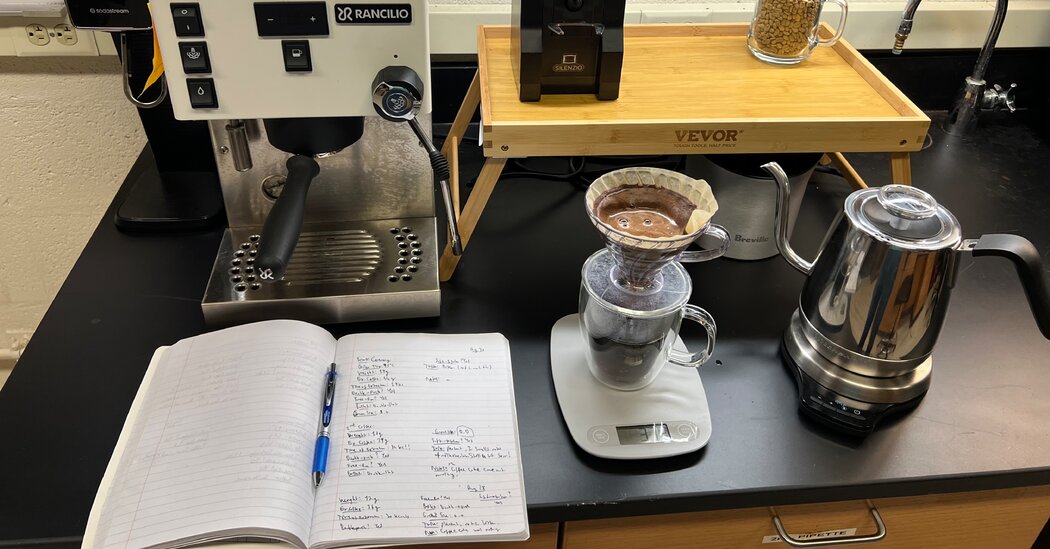Greater than a billion glasses of espresso are consumed each day: French-stall, espresso, chilly Vara, no matter is required.
Arnold Matizen, a physicist on the College of Pennsylvania, is partial for espresso transfusion that includes manually pouring scorching water on floor beans and filtering right into a saucepan or mug beneath. Actually, he realized that the applying of the rules of the dynamics of the fluid to the method may make it even higher.
With two college students with an analogous thoughts, Dr. Matidies begins to learn to optimize the pouring of pouring. Their suggestions, supported by science: pour excessive, gradual and regular water move. This ensures the most important extraction from minimal grounds, enhancing the aroma of espresso with out added beans or worth.
Thehe findingsPrinted this month at Physics of Fluids, emphasize how the processes that develop within the kitchen – from Fua Grassi sure Breaking a plate with Cassio and Pepe – It might encourage new scientific instructions. In flip, science can enhance the artwork of the kitchen.
“Kitchen science begins with a comparatively low entry barrier,” stated Dr. Matyussen. “Nevertheless it’s extra than simply candy. Generally elementary issues can come out of it.”
Mathijssen primarily research the physics of organic flows, as the way in which micro organism swim upstream within the blood vessels. However when he misplaced entry to his laboratory whereas stopping Covid-19, he started to play together with his food-literal meals. He shook bottles of whiskey, examined the stickiness of pasta, and slid cash on slopes product of whipped cream and honey. Curiosity ended with a View 77 PagesStructured as a menu of physics concerned in meals preparation.
“It occurred fully out of the palms,” stated Dr. Matissen. “You simply notice that science is in all places.”
Since then, Mathijssen has returned to the laboratory, however the ardour for kitchen physics has struck. The espresso survey was partly impressed by a scientist in his band, who led detailed notes for breweries daily ready on the lab daily. The notes included details about the place the beans got here from, the extraction time and the style profile of cooking.
Ernest Park, a graduate pupil within the laboratory, designs an official experiment. Utilizing silica beads in a glass cone, scientists simulate the motion of water, which is poured on cafes from completely different heights, recording the dynamics of the system with a excessive -speed digital camera.
Then they cooked pots with actual espresso, pouring out of the gooseneck kettle at completely different heights. The ensuing liquid was allowed to evaporate within the oven till every part else was the espresso particles extracted from the foundations.
They discovered that extra particles of espresso stay when they’re slowly poured, which will increase the time when the water is involved with the websites. Holding the kettle has helped larger in mixing, stopping water from draining into the perimeters, between the bases and the filter.
One of these move precipitated what researchers have outlined as an avalanche. Water erodes the middle of the pile of espresso, thus hanging among the nipples which are established and constructed on the facet. In the long run, the perimeters collapsed in and the method started once more. This elevated the aroma extracted from the cafe, however solely till the water was allowed to move repeatedly.
“Your jet of water popping out ought to seem like a clean column to the tip,” says Margo Younger, a graduate pupil, and a former barista collaborating within the research. “In the event you see that it begins to collapse or you may see droplets, then it’s best to pour out from the underside down.”
Scientists have performed casual style exams, though they didn’t make it the ultimate publication. “Style, it is vitally subjective,” stated Mr. Park. “So we at all times counsel you attempt it your self.”
The Park famous that the survey examined solely water poured into the middle of the cafeteria, though future experiments may discover different strategies, equivalent to making vortices or spirals.
The scientific phenomena noticed within the kitchen often have analogues outdoors its partitions. The dynamics between a jet of scorching water and a mattress of espresso beans, for instance, are just like the erosion of the earth, which might happen round waterfalls and dams. The stirred saucepan soup takes on the identical form because the liquid mirrors of some telescopes. Observations of Agnes Pokel cleaning soap bubbles, German hosts of the nineteenth century, breeds the area of surface science And laid the foundations of nanotechnology.
In 2022, Mathijssen helped to assemble a variety of research produced by scientists all over the world in a set referred to as Kitchen streamsS Now he helps to compile a Second collectionwhich up to now consists of greater than 30 research, together with insights in egg yolkThehe Piping a bottle of beer and The most effective way of brewing pastaS
Dr. Mathijssen additionally plans to proceed exploring the various paths for good espresso, equivalent to physics behind the formation of layers of milk and espresso in latte. “I need to do some extra work on this course,” he stated. “After which possibly one thing concerning the chilly boils.”

